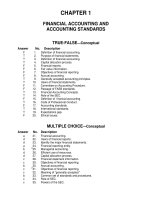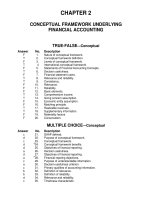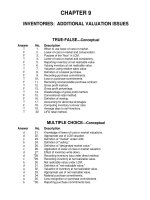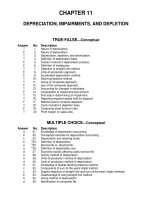Intermediate accounting 16e by kieso slide ch17
Bạn đang xem bản rút gọn của tài liệu. Xem và tải ngay bản đầy đủ của tài liệu tại đây (3.11 MB, 128 trang )
17-1
PREVIEW OF CHAPTER 17
Intermediate Accounting
16th Edition
Kieso ● Weygandt ● Warfield
17-2
17
Investments
LEARNING OBJECTIVES
After studying this chapter, you should be able to:
1
Understand the accounting for investments in debt
3
securities.
2
Understand the accounting for investments in equity
securities.
17-3
Explain the equity and consolidation methods of
accounting.
4
Evaluate other major issues related to investments in
debt and equity securities.
LO 1
INVESTMENT IN DEBT SECURITIES
Different motivations for investing:
17-4
To earn a high rate of return.
To secure certain operating or financing arrangements with another company.
LO 1
INVESTMENT IN DEBT SECURITIES
Companies account for investments based on
the type of security (debt or equity) and
their intent with respect to the investment.
ILLUSTRATION 17-1
Summary of Investment Accounting Approaches
17-5
LO 1
Debt Investment Classifications
Debt securities represent a creditor relationship:
Type
17-6
Accounting Category
U.S. government securities
Held-to-maturity
Municipal securities
Trading
Corporate bonds
Available-for-sale
Convertible debt
Commercial paper
LO 1
Debt Investment Classifications
ILLUSTRATION 17-2
Accounting for Debt
Amortized cost is the acquisition cost adjusted for the amortization of discount or
Securities by Category
premium, if appropriate.
17-7
LO 1
INVESTMENT IN DEBT SECURITIES
Held-to-Maturity Securities (Amortized Cost)
Classify a debt security as held-to-maturity only if it has both
1)
the positive intent and
2)
the ability to hold securities to maturity.
Accounted for at amortized cost, not fair value.
Amortize premium or discount using the effectiveinterest method unless the straight-line method yields
a similar result.
17-8
LO 1
Held-to-Maturity Securities (Amortized Cost)
Illustration: Z-Smith Company purchased $100,000 of 8 percent bonds of Bush Corporation on January 1, 2016,
at a discount, paying $92,278. The bonds mature January 1, 2021 and yield 10%; interest is payable each July 1
and January 1. Z-Smith records the investment as follows:
January 1, 2016
Debt Investments
Cash
17-9
92,278
92,278
LO 1
ILLUSTRATION 17-3
Schedule of Interest Revenue and Bond Discount Amortization—
Effective-Interest Method
17-10
LO 1
ILLUSTRATION 17-3
Illustration: Z-Smith Company records the receipt of the first semiannual interest payment on July 1, 2016, as
follows:
Cash 4,000
Debt Investments
Interest Revenue
17-11
614
4,614
LO 1
ILLUSTRATION 17-3
Illustration: Z-Smith is on a calendar-year basis, it accrues interest and amortizes the discount at December 31,
2016, as follows:
Interest Receivable
Debt Investments
Interest Revenue
17-12
4,000
645
4,645
LO 1
Held-to-Maturity Securities (Amortized Cost)
Reporting of Held-to-Maturity Securities
ILLUSTRATION 17-4
Reporting of Held-to-Maturity Securities
17-13
LO 1
Held-to-Maturity Securities (Amortized Cost)
ILLUSTRATION 17-3
Illustration:
Assume Z-Smith sells its
investment in Bush bonds on
November 1, 2020, at 99¾
plus accrued interest. ZSmith records discount
amortization as follows:
Calculation of amortization =
Debt Investments
Interest Revenue
17-14
$952 x 4/6 = $635
635
635
LO 1
Held-to-Maturity Securities (Amortized Cost)
Computation of Gain on Sale of Bonds
ILLUSTRATION 17-5
Cash 102,417
Interest Revenue (4/6 x $4,000)
Debt Investments
Gain on Sale of Securities
17-15
2,667
99,683
67
LO 1
INVESTMENT IN DEBT SECURITIES
Available-for-Sale Securities
Companies report available-for-sale securities at
fair value, with
unrealized holding gains and losses reported as other comprehensive income, a separate component
of stockholder’s equity, until realized.
Any discount or premium is amortized.
17-16
LO 1
Debt Securities
Available-for-Sale Securities
Illustration (Single Security): Graffeo Corporation purchases $100,000, 10 percent, five-year bonds on January 1,
2016, with interest payable on July 1 and January 1. The bonds sell for $108,111, which results in a bond premium
of $8,111 and an effective interest rate of 8 percent. Graffeo records the purchase of the bonds on January 1, 2016,
as follows.
Debt Investments
Cash
17-17
108,111
108,111
LO 1
ILLUSTRATION 17-6
Schedule of Interest Revenue and Bond Premium Amortization—
Effective-Interest Method
17-18
LO 1
ILLUSTRATION 17-6
Illustration (Single Security): The entry to record interest revenue on July 1, 2016, is as follows.
Cash 5,000
17-19
Debt Investments
676
Interest Revenue
4,324
LO 1
Debt Securities
Available-for-Sale Securities
Interest Revenue for 2016
= $8,621
ILLUSTRATION 17-6
Illustration (Single Security): At December 31, 2016, Graffeo makes the following entry to recognize interest
revenue.
Interest Receivable
17-20
5,000
Debt Investments
703
Interest Revenue
4,297
LO 1
Available-for-Sale Securities
Debt Securities
ILLUSTRATION 17-6
Illustration (Single Security): To apply the fair value method to these debt securities, assume that at December 31,
2016 the fair value of the bonds is $105,000. Graffeo makes the following entry.
Unrealized Holding Gain or Loss—Equity
Fair Value Adjustment
17-21
1,732
1,732
LO 1
Available-for-Sale Securities
Debt Securities
Illustration (Portfolio of Securities): Herringshaw Corporation has two debt securities classified as available-forsale. The following illustration identifies the amortized cost, fair value, and the amount of the unrealized gain or loss.
ILLUSTRATION 17-7
Computation of Fair Value Adjustment—Available-for-Sale Securities (2017)
17-22
LO 1
Available-for-Sale Securities
Debt Securities
ILLUSTRATION 17-7
Prepare the adjusting entry Herringshaw would make on December 31, 2017 to record the loss.
Unrealized Holding Gain or Loss—Equity
Fair Value Adjustment
17-23
9,537
9,537
LO 1
Available-for-Sale Securities
Debt Securities
Sale of Available-for-Sale Securities
If company sells bonds before maturity date:
17-24
It must make entries to remove from the Debt Investments account the amortized cost of bonds sold.
Any realized gain or loss on sale is reported in the “Other” section of the income statement.
LO 1
Sale of Available-for-Sale Securities
Illustration: Herringshaw Corporation sold the Watson bonds (from Illustration 17-7) on July 1, 2018, for $90,000, at
which time it had an amortized cost of $94,214.
ILLUSTRATION 17-8
Computation of Loss on Sale of Bonds
Cash 90,000
Loss on Sale of Investments
Debt Investments
17-25
4,214
94,214
LO 1









